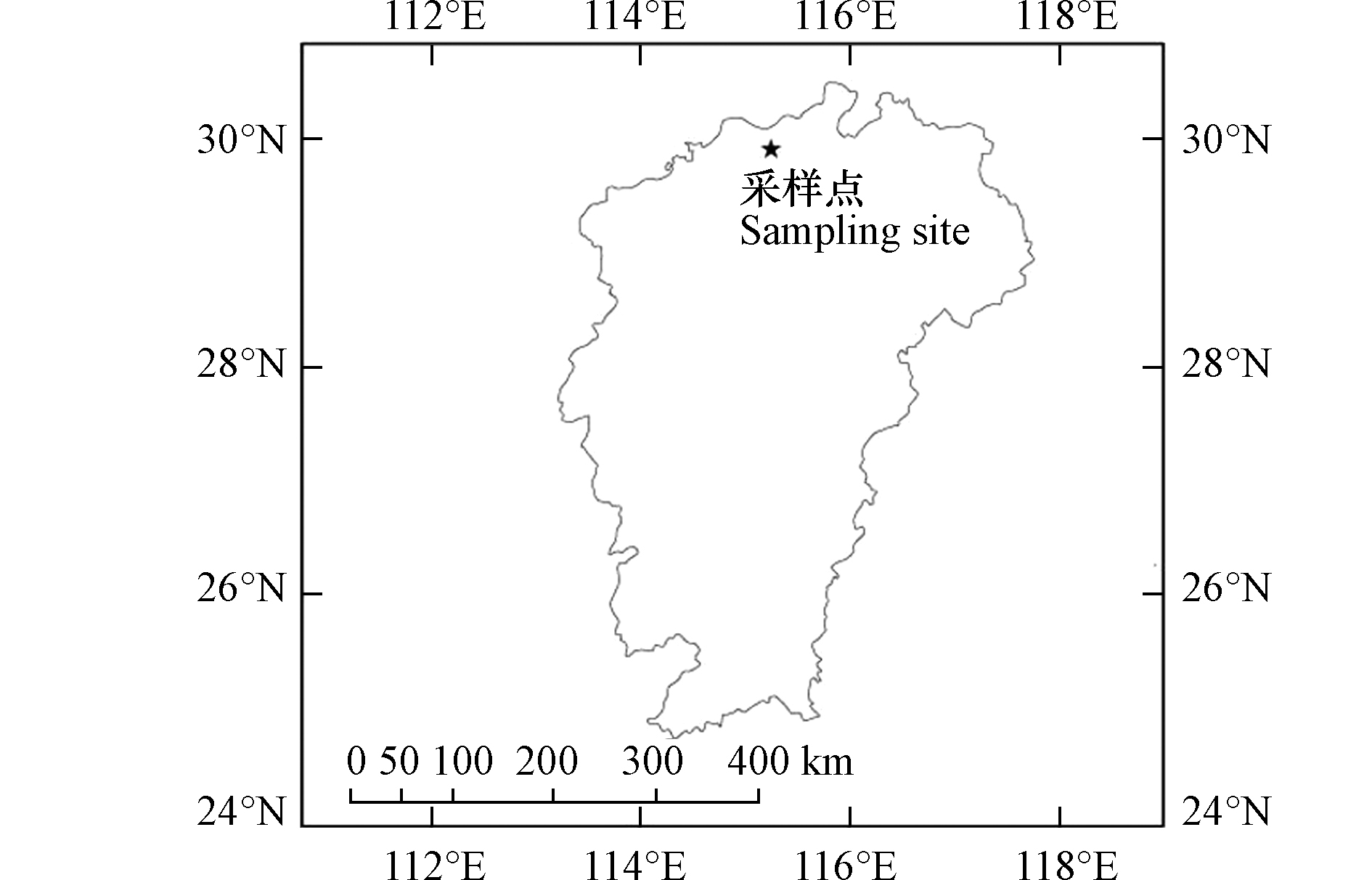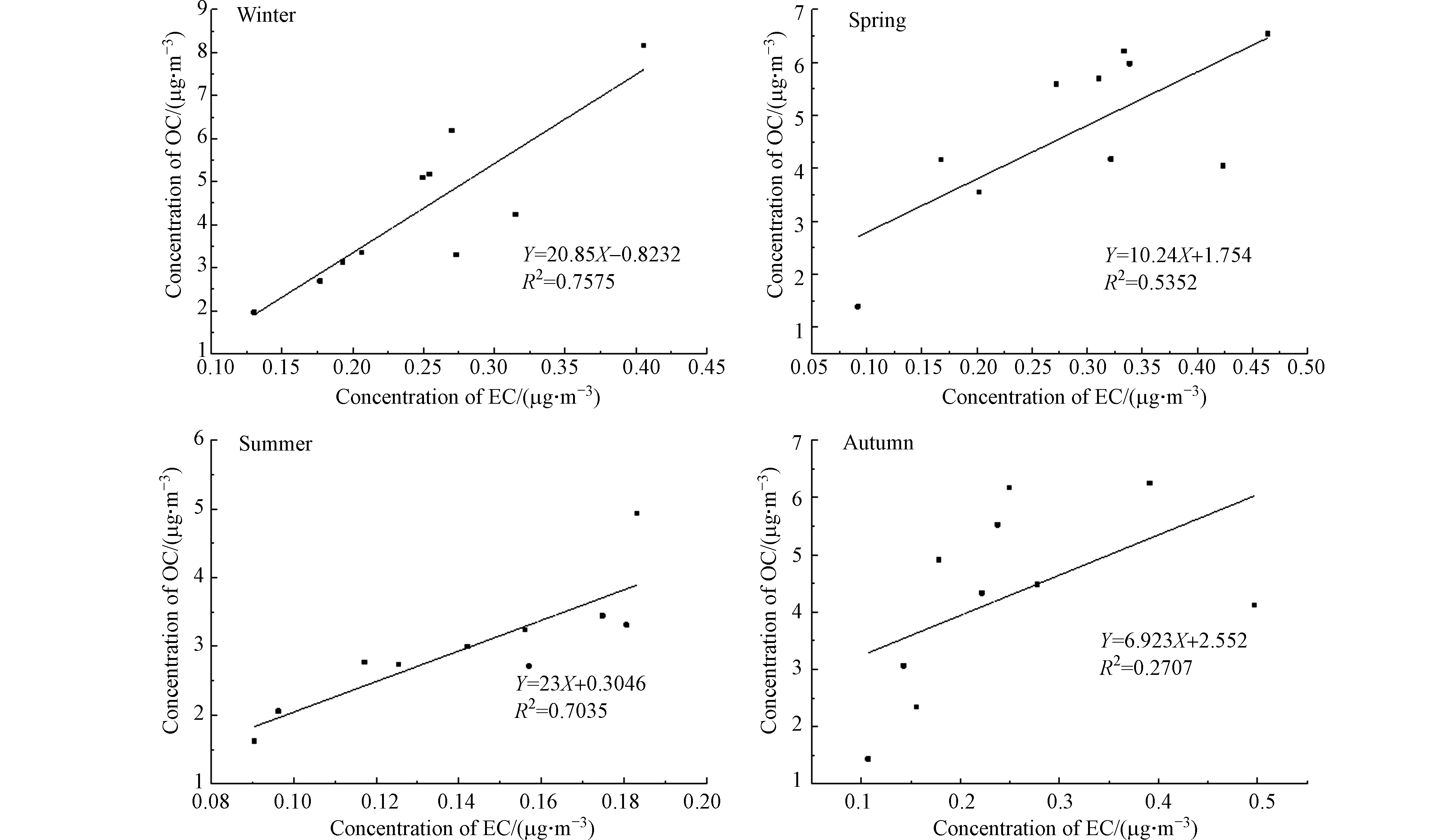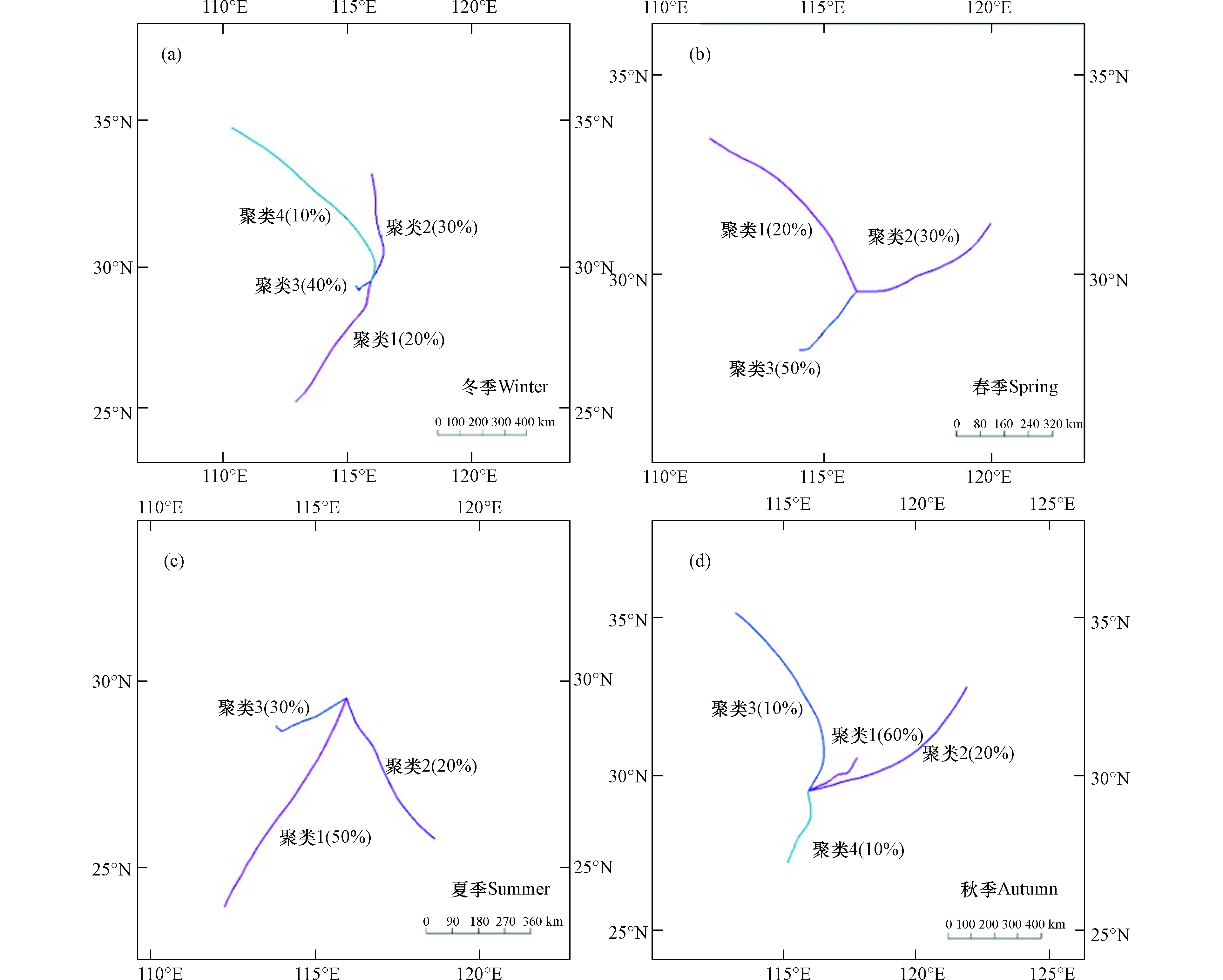-
碳质气溶胶是大气颗粒物的重要组成部分,占PM2.5质量浓度的20%—60 %,通常以有机碳(organic carbon, OC)和元素碳(elemental carbon, EC)的形式存在。OC的来源主要包括燃煤排放与生物源直接排放的一次有机碳(POC)和由气态前体物经过大气光化学反应生成的二次有机碳(SOC);EC主要由生物质燃烧和化石燃料的不完全燃烧产生[1-2]。碳质气溶胶对环境、气候、能见度和人体健康等方面具有重要影响,OC富含致癌、致基因突变、致畸等有害物质[3],且可以散射太阳辐射,具有冷却效应,部分水溶性有机碳可以影响云凝结核性质[4];而EC因其对太阳辐射有较强的吸收作用,会产生正的辐射强迫,被认为是仅次于CO2的气候变暖增温组分[5]。因此研究碳质气溶胶污染特征具有重要意义。
目前我国对碳质气溶胶的观测主要集中在污染程度较高的京津冀、长江三角洲和珠三角等城市地区,结果发现城市地区碳质组分污染比较严重[6-8]。例如天津市采暖季PM2.5中OC和EC在PM2.5中分别占23.78%和6.38%,是PM2.5的重要组成成分[9];南京春季北郊地区有88%观测天存在明显的二次有机污染[10]。而高山背景站通常海拔较高,大气环境受周围局地污染影响较小,更易受长距离传输的影响,因此可以更大尺度地反应区域大气环境的特征[11]。近年来对背景高山地区的碳质气溶胶观测也逐渐开展,发现背景高山区域的碳质颗粒浓度远低于城市地区,且浓度的高低与其来源和形成机理密切相关。例如华南背景区域鼎湖山站碳质气溶胶的研究表明该站点碳质气溶胶来源比较复杂且OC和EC质量浓度呈现明显的季节变化[12];泰山夏季PM2.5中元素碳(EC)质量浓度处于较低水平,且高湿条件可以降低气溶胶的酸度进而抑制生物源二次有机气溶胶(BSOA)通过酸催化氧化反应的形成[13];黄山光明顶观测期间大气气溶胶中EC主要是外部输送,OC既存在外部输送也存在局地贡献,且外部输送主要来自东部城市群和西北地区以及武汉一带[14]。但是碳质组分的来源比较复杂,还需要进一步研究。庐山风景区作为我国著名的旅游风景区和避暑疗养胜地,是我国城市居民进行生态休憩的重要场所,其大气颗粒物的污染直接关系到人体的健康和环境景观质量。且庐山风景区是典型的高山背景点,其海拔较高,地面污染源对其直接影响较小,且大气湍流运动显著,因此,高山观测不仅可以反映区域大气污染状况,而且有助于研究污染物在对流层中的迁移转化和远距离传输规律。
本文于2019年—2020年期间在庐山风景区居民区对PM2.5颗粒物进行采样,分析PM2.5及其OC和EC的浓度水平和季节变化特征,并采用不同的方法对OC和EC的可能来源进行分析和讨论,旨在了解高山风景区背景区域碳质颗粒时空分布特征及来源。由于庐山风景区当地排放的碳质颗粒来源有限,因此更具有区域代表性,研究其碳质颗粒物不仅有助于了解人为因素对颗粒物的影响程度,还能为研究污染物传输及生物化学循环奠定基础。
-
本研究于2019年12月2日至2020年10月31日期间在江西庐山风景区进行大气PM2.5样品采集,采样点(115°58′E,29°33′N)位置如图1所示,共采集样品89个,每个季节随机选择一个月的样品进行分析,共分析了40张样品,每张样品的采样时长72 h。庐山风景区隶属江西省九江市,地处亚热带季风气候区,山地气候特征明显,四季分明,夏短冬长,年平均气温为11.6 ℃,年平均相对湿度75%,年降水量可达1950—2000 mm,雨水充足,日照丰富,由于植物生长茂密,叶片蒸腾作用强,加之山上海拔高、气温低、湿度大,庐山经常出现云雾和大风天气,云雾日年均为200 d,大风日为100 d。庐山周围有九江、武汉、南昌、景德镇、黄石等城市和工业区,庐山顶部有枯岭镇,常住居民万余人,大多从事旅游或相关服务行业,局地污染源较少[15]。采样点设置在枯岭镇居民区,海拔1062 m,周边为居民区民宿及风景旅游景点,附近无工业污染源,主要污染源为周边居民日常生活的排放,能够代表庐山风景区居民区的一般污染特征。
使用KC-1000型大流量TSP采样器采集环境空气中的 PM2.5 样品,采样的平均流量 1.05 m3·min−1,采样滤膜有效面积为180 mm×230 mm石英滤膜。样品采集前都采集了空白滤膜,在进行采样前对所有石英滤膜进行烘干处理,在马弗炉中450 ℃高温煅烧4 h以去除石英滤膜中附着的可能污染物,然后在恒温恒湿条件下平衡24 h。采样前后滤膜都放置于铝箔中,采样后样品滤膜放置于−20 ℃的冰箱里面,等待分析处理。使用精度为 为0.00001 mg的电子分析天平(FA2004)称量采样膜采样前后的质量,并计算颗粒物样品的质量浓度。参照GB/T 15432−1995 和 HJ618-2011 (GB 6921−86)标准测定 PM2.5 的质量浓度。
-
颗粒物中的碳质组分OC/EC分析采用半连续OC/EC分析仪(美国Sunset Laboratory),该仪器的原理是热光透射法(thermal-optical transmittance,TOT)。具体步骤如下:使用切膜器取1cm×1.5 cm面积的样品膜放入仪器托盘中进行分析,分析过程可分为两个阶段,第一阶段,在无氧氦气的环境条件下以310 ℃、475 ℃、615 ℃和870 ℃的温度梯度逐级升温,这一阶段生成OC1、OC2、OC3、OC4,在这个过程中有一部分OC被碳化转化为裂解碳(OPC);第二阶段,通入10% O2+90% He的混合气体,以550 ℃、625 ℃、700 ℃、775 ℃、850 ℃、870 ℃的温度逐级升温,这一阶段生成EC1、EC2、EC3、EC4、EC5、EC6,两个阶段生成的气体经过MnO2催化氧化为CO2,最后用火焰离子检测器进行定量。在整个过程中,都有一束激光打在石英膜上,其透射光在 OC 碳化时会减弱,当切换载气,升高温度时,EC 会被氧化分解,激光束的透射光的光强就会逐渐增强。当恢复到最初的透射光强时,这一刻就被认为是 OC、EC 分割点,此时刻之前检出的碳为OC,之后检出的为EC[16]。碳组分OC的浓度为:OC=OC1+OC2+OC3+OC4+ OPC,EC=EC1+EC2+EC3+EC4+EC5+EC6−OPC。
-
目前对OC和SOC的区分尚无直接方法测定,常用的间接方法有EC示踪法、有机分子示踪法和模型预测法等[17-20]。其中EC示踪法也称为OC/EC比值法,具有便捷、有效等特点。因而常被广泛应用。其计算公式为:
式(1)中,POC为一次有机碳,式(2)中,(OC/EC)min为OC/EC比值最小值,由于降水和大风等过程会对OC、EC有不同程度的清除作用,为选取较为准确的(OC/EC)min值,排除大风和降雨天气等气象条件下的观测后确定采样期间的OC/EC最小值。考虑到各采样点位不同季节的气象条件和污染源排放差异性,本文中以各采样点位不同季节监测到的(OC/EC) min来计算不同季节的 SOC。因为OC/EC的比值受到排放源以及大气中氧化性物质浓度的影响,所以即使是各季节OC/EC最小值的样品中仍可能会含有少量有机碳,因此采用这种估算方法得到的结果会比实际值低。
-
后向轨迹方法在许多研究中常被用来分析气团来向,研究不同来源的气团对区域污染的作用。为了深入研究跨区域输送对庐山风景区典型居民区采样点各季节污染特征的影响以及污染物的溯源,利用Meteolnfo 2.1软件分析2019年12月2日—2020年1月4日、2020年3月13日—4月14日、2020年7月14日—8月16日和2020年9月29日—10月31日四个季节的主要气团来源,模拟高度对应庐山海拔高度1165 m,其后向轨迹能代表庐山大气整体的来源,模拟时间为24 h后向轨迹,用于追踪抵达庐山风景区居民区的气团过去24 h的输送路径。利用聚类分析法对所有轨迹进行合并分类,轨迹的路线和方向代表气团在到达观测点之前所经过的区域,根据轨迹路线长短可以判断气团的移动速度,长轨迹表明气团移动速度快,短轨迹表明气团移动过速度慢。同时每条轨迹添加了OC、EC的质量浓度配合分析。
-
分析采样期间庐山风景区居民区PM2.5污染状况,结果如图2所示。采样期间PM2.5质量浓度水平分布在18.19—87.16 μg·m−3之间,平均浓度为(46.45±18.64)μg·m−3。与环境空气质量标准相比,庐山风景区居民区的PM2.5浓度是一级标准限值(35 μg·m−3)的1.33倍,低于二级标准限值(75 μg·m−3)。说明庐山风景区居民区存在一定的细颗粒污染。庐山风景区居民区PM2.5浓度表现出明显的季节性变化特征,冬季、春季、夏季和秋季的PM2.5质量浓度水平分别分布在38.52—80.91 μg·m−3、23.04—84.88 μg·m−3、8.19—57.04 μg·m−3和25.33—87.16 μg·m−3之间,平均浓度分别是(55.60±17.04) μg·m−3、(54.49±17.18)μg·m−3、(30.38±10.40)μg·m−3和(44.72±18.59)μg·m−3,呈现冬季>春季>秋季>夏季的分布特征,与南昌季节分布情况一致[21]。说明庐山风景区居民区在夏季空气清洁,质量较好。
庐山风景区居民区PM2.5与各气象要素有密切关系。由图2可以看出,强降雨后PM2.5的浓度明显降低。例如8月9日开始持续4 d强降雨后,导致8月12日PM2.5浓度达到最低值。10月14日—10月18日处于雨期,使得10月18日的PM2.5浓度处于低值。这说明湿沉降是PM2.5有效清除的机制。而10月19—22日期间温度较低,空气相对湿度较大,这些气象条件均有利于颗粒物的积累,且基本无有效降雨,最终导致PM2.5浓度迅速上升达到最大值84.88 μg·m−3。
庐山风景区居民区PM2.5浓度在冬、春季较高,可能的原因有:一是冬季气温低,降雨量少,促进了大气气相中半挥发性有机物向大气颗粒相中富集,这在一定程度上能够加剧PM2.5污染程度[22],二是冬、春季节容易出现逆温层和多雾天气,导致大气颗粒物不易扩散。夏季PM2.5浓度水平最低,夏季风向集中,以南风为主,且夏季大气湍流运动活跃,空气对流强度大,有利于污染物的扩散[23],再者夏季降雨量多,湿沉降的作用能够加快污染物的沉降,使得PM2.5颗粒物浓度降低。
表1总结了国内部分城市地区和高山背景点PM2.5的质量浓度水平,可以看出庐山风景区居民区PM2.5浓度水平明显低于城市地区,如天津((86.0±46.9)μg·m−3)[8],北京(109.9 μg·m−3)[24],上海(50.41 μg·m−3)[25],广州((66.03±43.11) μg·m−3)[26],和南昌(69.1 μg·m−3)[27]等城市地区采样期间PM2.5浓度水平,都远高于庐山风景区居民区PM2.5浓度水平;与国内其他典型高山背景点相比,庐山风景区居民区采样点PM2.5浓度高于同在华中地区的衡山(40.7 μg·m−3)[28],高于东北地区的长白山(38.8 μg·m−3)[29],高于华东地区的泰山(42.2 μg·m−3)[30]。表明庐山背景点PM2.5浓度低于城市地区,但与国内其他高山背景点比较接近。相比于2011夏季[31],庐山PM2.5浓度水平下降了48.3%,这有可能与2020年新冠疫情疫情防控相关,相关研究[32]表明在进行新冠疫情防控相关工作之后机动车、工业源的各污染排放量大幅降低,最终导致PM2.5浓度显著降低。
-
采样期间庐山风景区居民区PM2.5中OC、EC的浓度变化水平如图3所示,OC和EC质量浓度变化水平分别分布在1.39—8.16 μg·m−3和0.09—0.50 μg·m−3之间,平均值分别是(4.08±1.61) μg·m−3和(0.23±0.10)μg·m−3,OC和EC在PM2.5中所占的比例分别是8.78%和0.50%。说明庐山风景区居民区PM2.5中的OC和EC含量较低, 且OC的含量远远高于EC的含量。同时庐山风景区居民区OC和EC具有明显的季节变化特征,表现为春季>冬季>秋季>夏季。其中,冬季OC和EC的质量浓度水平分别分布在1.96—8.16 μg·m−3(平均值为(4.33±1.86)μg·m−3)和0.13—0.41 μg·m−3(平均值(0.25±0.08)μg·m−3)之间。春季分别在1.39—6.54 μg·m−3(平均值为(4.73±1.58)μg·m−3)和0.09—0.46 μg·m−3(平均值(0.29±0.11)μg·m−3)之间。夏季分别在1.62—4.94 μg·m−3(平均值(2.98±0.89)μg·m−3)和0.09—0.18(平均值为(0.14±0.03)μg·m−3)之间。秋季分别在1.44—6.25 μg·m−3(平均值为(4.26±1.59)μg·m−3)和0.11—0.50 μg·m−3(平均值(0.25±0.12)μg·m−3)之间。
庐山风景区居民区PM2.5中OC和EC的浓度水平在春、冬季较高可能是因为污染物排放增加,且冬、春季节大气边界层稳定,逆温频率高,不利于污染物的扩散,造成污染物浓度升高。夏季OC和EC浓度最低,可能是由于夏季降雨频繁,雨水的冲刷加速了大气颗粒物的湿沉降,且夏季大气不稳定,空气对流良好,有利于碳质气溶胶的扩散,使得OC和EC的浓度水平处于较低值。
国内其他站点OC和EC质量浓度水平如表1所示, 庐山风景区居民区PM2.5中OC和EC浓度水平远低于天津[8]、北京[24]、上海[25]、广州[26]、南昌[27]等城市地区,与我国其他高山背景点相比,庐山风景区居民区OC和EC浓度水平低于鼎湖山[12]、华山[28]、长白山[29],高于泰山[13]、衡山[28]背景点。表明庐山风景区居民区碳质颗粒的污染水平普遍低于城市地区,介于国内其他典型高山背景点之间。相比于2011年夏季[31],庐山OC质量浓度下降了21.2%,而EC质量浓度下降了89.1%,这可能与不同的采样时间、采样周期、热光分析方法的差异以及2020年的新冠疫情政策调控有关。
-
有研究表明,OC/EC的比值能够用来识别碳质颗粒的排放和转化特征以及评价和鉴别颗粒物的二次来源。CHOW等认为,当OC/EC比值大于2时,表明OC中存在SOC[33]。Appel等[34]也认为,较高的OC/EC比值可能来自光化学反应生成的二次有机污染物。庐山风景区居民区OC/EC值变化如图4所示,由图4可知,OC/EC比值在8.3—27.6之间,平均值为18.40,表明庐山风景区去居民区存在SOC的生成。庐山植被覆盖率高,植物生长旺盛,会排放较多的挥发性有机物,挥发性有机物通过光化学反应形成SOC,可使得OC浓度增加致使OC/EC较大,同时采样点作为居民区,部分居民燃烧柴火进行烹饪等,庐山上的的寺庙也常有不定期的大型祭祀活动,祭通常伴随着大量的烧香,因此可能会形成较多的生物质燃烧使得OC/EC较大 。Na等[35]在研究中也发现,仅从OC/EC比值较高还不能判断有较多SOC的生成,因为排放源和来源区域的变化会导致OC/EC比值的变化。
-
VOCs在适宜的温度和光照条件下容易发生光化学反应生成SOC,庐山风景区居民区SOC质量浓度及SOC/OC变化如图5所示,庐山风景区居民区SOC质量浓度分布在0.03—4.09 μg·m−3之间,平均值为(1.51±1.22) μg·m−3,在OC中所占比例在3.62%—69.92%之间,平均占比为33.20%,说明SOC是庐山风景区居民区PM2.5中OC的重要组成部分。与国内其他高山背景地区相比,庐山风景区居民区SOC转化率高于金鼎山(23.7%)、低于西山森林公园(47.7%)[36]。其中庐山风景区居民区冬季SOC的平均质量浓度为(1.34±1.16)μg·m−3,春季为(1.94±1.08) μg·m−3,夏季为(0.53±0.50)μg·m−3,秋季为(2.22±1.36)μg·m−3,冬、春、夏、秋季SOC在OC中所占比例分别为27.04%、39.82%、15.97%和49.96%。4个季节SOC的质量浓度均比POC小,表明庐山风景区居民区PM2.5中OC以一次排放为主,庐山是我国著名的旅游风景区和避暑疗养胜地,人们的旅游活动、居民生活以及庐山内的寺庙烧香祭祀活动等可形成大量的一次排放源。其中秋季SOC对OC的贡献率最高,夏季贡献率最低,春季、秋季不易于扩散的气象因素有利于环境中的污染物进一步转化为SOC,促使SOC浓度增加。夏季SOC的转化率最低,夏季气温高、太阳辐射强的气象条件通常有利于SOC的转化,但是夏季高温、多雨的气象条件也促进了SOC的分解,从而导致夏季的SOC的净生成率低于其他季节。
-
前文采用OC/EC比值法发现采样期间有较多的二次污染。碳质气溶胶的来源复杂,为了进一步了解庐山风景区居民区碳质颗粒的来源,通过主成分分析法对采样期间10种碳质组分(OC1、OC2、OC3、OC4、EC1、EC2、EC3、EC4、EC5和EC6)进行分析结果如表2所示。相关研究表明,OC1来自生物质燃烧排放、燃煤排放、机动车尾气排放,OC2来自土壤尘、生物质燃烧排放、燃煤排放,OC3来自土壤尘和燃煤排放,OC4来自燃煤排放和土壤尘,EC1、EC2主要来自于汽油车排放,EC3、EC4、EC5主要来自柴油车尾气排放,EC6来源于燃煤和土壤尘[37]。由表2可知,庐山风景区居民区PM2.5中碳质组分主要受3个因子的影响,3个因子的方差总贡献率为86.844%,因子1载荷值较大的变量为OC2、OC3等,方差贡献率为32.731%,代表燃煤、生物质燃烧和土壤尘的影响,因子2载荷值较大的变量为OC1、EC1、EC2,方差贡献率为31.997%,说明因子2受汽油车尾气、生物质燃烧的影响;因子3方差贡献率为22.117%,载荷值较大的变量为EC5、EC6,说明因子3受柴油车尾气的影响。综上结果表明庐山风景区居民区PM2.5中的碳质颗粒主要受到燃煤燃烧、生物质燃烧、土壤尘、机动车尾气排放等的影响。采样点为居民区,居民日常生活烹饪过程中使用煤和木材等燃烧释放较多OC、EC;采样点附近有公路,常有机动车经过,机动车的运行和燃料燃烧可以排放OC和EC,而在本次研究中大部分机动车尾气的碳质成分以OC为主。
除此以外,还分析了不同季节OC和EC的相关性如图6所示。一般来说EC主要是来源于含碳燃料的燃烧排放,稳定性相对较强,在大气中可以稳定存在,常被用来表征一次人为大气污染,OC的来源相对较复杂,不仅能产生于化石燃料的燃烧,还有大气中的有机气体进行光化学反应生成的SOC,因此可以通过OC和EC的相关性来识别含碳气溶胶的来源。若OC和EC的相关性强,则说明两者的来源相同或相近,反之,则两者来源不同。由图可知,庐山风景区居民区冬季、春季、夏季和秋季OC、EC的相关系数R2分别为0.7575、0.5352、0.7035和0.2707。其中冬季、夏季的OC和EC的相关性相对较好,呈显著正相关(P<0.01),表明冬季和夏季的OC和EC有着相似的来源;春季和秋季OC和EC 的相关性相对较弱,表明碳颗粒物的来源相对复杂。
综合上述分析可以得出,庐山风景区居民区碳质颗粒主要来源于燃煤燃烧、生物质燃烧、土壤尘、机动车尾气排放以及有机气体的光化学反应形成的SOC等,这结果与Li等[31]的研究结果相似。OC和EC的相关性表明冬季和夏季的OC和EC有着相似的来源,秋季和春季的碳质颗粒来源较复杂。
-
由于PM2.5可以在大气中长时间漂浮,所以可以进行长距离运输,因此大气颗粒物除受本地污染排放的影响外,还可能来自区域的污染传输。对观测期间庐山风景区居民区的PM2.5与TC(TC=OC+EC)进行相关性分析,得出PM2.5与TC的相关系数R=0.592,呈显著正相关(P<0.01),说明碳组分与PM2.5有着相似的迁移转化规律。Li等[31]探讨了夏季庐山碳质来源及可能的形成过程,表明庐山的碳质颗粒受到外来输送的影响。
分析采样期间外来输送对庐山风景区居民区碳质颗粒物浓度的影响,结果如图7所示。由图7a可知, 冬季气团轨迹可分为4类,轨迹聚类1和聚类3来自西南方向,出现概率分别为20%和40%,聚类1主导下的OC、EC平均浓度为5.73 μg·m−3和0.34 μg·m−3,聚类3主导下的OC、EC平均浓度为3.98 μg·m−3和0.21 μg·m−3。聚类2和聚类4主要来自北方,出现概率分别为30%和10%,聚类2主导下的OC、EC平均浓度为3.57 μg·m−3和0.24 μg·m−3,聚类4主导下的OC、EC平均浓度为5.18 μg·m−3和0.25 μg·m−3。其中轨迹1的OC、EC污染最严重,表明庐山风景区居民区PM2.5的碳质颗粒主要来自西南和西北方向。由图7b可知, 春季气流轨迹可聚类为3类,其中聚类1的气团轨迹主要来自西北方向,出现概率为20%,其主导下的OC、EC的平均浓度最高,为4.87 μg·m−3和0.37 μg·m−3,聚类2主要是来自东北方向的气流轨迹,出现概率为30%,其主导下的OC、EC平均浓度为4.52 μg·m−3和0.25 μg·m−3,聚类3主要是来自西南方向的气流,出现概率为50%,其主导下的OC、EC浓度为4.80 μg·m−3和0.29 μg·m−3。 由图7c可知夏季气流轨迹可分为3类,其中聚类1和聚类3来自西南向,出现概率分别为50%和30%,聚类1主导下的OC和EC的平均浓度分别为2.52 μg·m−3和0.13μg·m−3,聚类3主导下的 OC、EC的平均浓度分别为3.66 μg·m−3和0.16 μg·m−3,聚类2是来自东南反方向,出现概率为20%,其主导下的OC、EC平均浓度分别为3.12 μg·m−3和0.15 μg·m−3。由图7d可知, 秋季气流轨迹可聚类为4类,聚类1和聚类2主要是来自东北方向的气流,出现的概率分别为60%和20%,聚类1主导下的OC、EC平均浓度分别为4.34 μg·m−3和0.26 μg·m−3,聚类2主导下的OC、EC平均浓度分别为4.70 μg·m−3和0.15 μg·m−3,聚类 3主要是来自北方的气流,出现频率为10%,其对应的OC、EC平均浓度最高为6.25 μg·m−3和0.39 μg·m−3;聚类4来自江西中部,占总轨迹的10%,其对应的OC、EC平均浓度分别为4.91 μg·m−3和0.1.8 μg·m−3。综合上述,庐山风景区居民区采样期间导致PM2.5中碳质颗粒较高的气流主要来自北方及西南方的工业城市,夏季受夏季风暖湿气流的影响,自然污染源较少,同时夏季降雨较多在一定程度上可以稀释污染物,导致到达庐山风景区居民区的气流轨迹携带的污染物较少。
-
(1)庐山风景区居民区PM2.5全年平均浓度为(46.45±18.64)μg·m−3,OC和EC的浓度水平分别为(4.08±1.61)μg·m−3和(0.23±0.10)μg·m−3,其中OC和EC分别占PM2.5的8.78%和0.50%。OC和EC呈现明显的季节变化,两者均表现为春季>秋季>冬季>夏季。
(2)观测期间庐山风景区居民区PM2.5中OC和EC存在一定的正相关关系,在冬、夏季节OC和EC相关性较好,具有同源性,春、秋季较差,OC和EC来源相对较复杂,存在二次污染。PM2.5中SOC的平均浓度为(1.51±1.22)μg·m−3,在OC中占33.2%,SOC/OC具有明显的季节变化,呈现出秋季>春季>冬季>夏季。通过碳组分主成分分析,庐山风景区居民区OC和EC主要受到燃煤排放、生物质燃烧排放、机动车排放等排放源的影响。
(3)后向轨迹分析表明,庐山风景区居民区采样期间导致PM2.5中碳质颗粒较高的气流主要来自北方及西南方的工业城市,夏季受夏季风暖湿气流的影响,自然污染源较少,同时夏季降雨较多在一定程度上可以稀释污染物,导致到达庐山风景区居民区的气流轨迹携带的污染物较少。
高山风景区居民区碳质气溶胶污染特征及来源
Characteristics and sources of carbonaceous aerosol in alpine scenic areas
-
摘要: 碳质气溶胶是大气颗粒物的重要组成部分,具有很强的环境和气候效应,是气溶胶科学研究领域的热点。为探究庐山风景区居民区PM2.5中碳质组分的污染特征及来源,于2019年12月2日—2020年10月31日在庐山风景区居民区进行PM2.5样品采集,并对其碳质组分有机碳(OC)和元素碳(EC)进行分析。结果表明,观测期间庐山风景区居民区PM2.5的平均质量浓度为(46.45±18.64) μg·m−3,其中OC和EC平均质量浓度分别是(4.08±1.61) μg·m−3和(0.23±0.10) μg·m−3,占 PM2.5总质量的8.78%和0.50%。且碳质颗粒的污染水平普遍低于城市地区,介于国内其他典型高山背景点之间。采用EC示踪法对PM2.5中的二次有机碳(SOC)进行估算,发现采样期间SOC的平均浓度为(1.51±1.22)μg·m−3,占OC的 33.2%,表明SOC是PM2.5中OC的重要组分。比较发现春秋两季二次转化率比冬夏两季二次转化率较低。通过碳组分主成分分析表明,除二次污染外,庐山风景区居民区OC和EC的含量受燃煤排放、生物质燃烧排放、机动车排放的影响。后向轨迹分析的结果表明,这些一次源排放的影响主要来自远距离输送。庐山风景区居民区采样期间导致PM2.5中碳质颗粒较高的气流主要来自北方及西南方的工业城市,夏季受夏季风暖湿气流的影响,自然污染源较少,同时夏季降雨较多在一定程度上可以稀释污染物,导致到达庐山风景区居民区的气流轨迹携带的污染物较少。OC和EC的相关性表明,庐山风景区居民区冬季和夏季OC和EC具有同源性,春季和秋季碳质组分来源较为复杂。Abstract: As an important component of atmospheric particulate matter (PM), has become a hot spot in the field of aerosol scientific research due to its’ severe environmental and climatic effects. In order to study the characteristics and sources of carbonaceous component in PM2.5 at the residential areas of Mount Lu Scenic Area, PM2.5 were collected from December 2, 2019 to October 31, 2020. The OC and EC in PM2.5 are analyzed using semi-continuous OC/EC analyzer (Sunset Laboratory, USA). The results showed that the average mass concentration of PM2.5 was (46.45±18.64) μg·m−3, in which the average mass concentration of OC and EC were respectively (4.08±1.61) μg·m−3 and (0.23±0.10) μg·m−3, accounting for 8.78% and 0.50% of the total mass of PM2.5. In addition, the pollution level of carbonaceous component in PM2.5 is generally lower than that of urban areas, and between the value of other typical high mountain background spots in China. The EC tracer method was used to estimate the secondary organic carbon (SOC) in PM2.5. It was found that the average concentration of SOC was (1.51±1.22) μg·m−3, accounting for 33.2% of the OC, indicating that SOC is an important component of OC in PM2.5 at the residential areas of Mount Lu Scenic Area. The results showed that SOC conversion rate in spring and autumn was lower than that in winter and summer. The concentration of SOC and O3 in the atmosphere are significantly positively correlated (R=0.566), indicating that the oxidation reaction of O3 as an atmospheric oxidant has a greater impact on the formation of SOC. The OC/EC ratio was between 8.3 and 27.6, further indicating that the residential areas of Mount Lu Scenic Area are seriously polluted by secondary pollution. The principal component analysis of carbon composition shows that, in addition to secondary pollution, the contents of OC and EC in residential areas of Mount Lu Scenic Area are affected by coal-fired emission, biomass combustion emission and motor vehicle emission. The results of the backward trajectory analysis show that these primary source emissions mainly come from long-distance transportation.PM2.5 and its carbonaceous components are significantly affected by the monsoon. During the sampling period, PM2.5 and its carbonaceous components in residential areas of Mount Lu Scenic Area are affected by the northwest monsoon in winter. Higher concentration of carbonaceous aerosol at Mount Lu scenic area residential areas are mainly affected by the air masses from the north and southwest industrial city. The summer samples are affected by summer wind warm current and the natural pollutants are less. In addition, more summer rainfall can dilute pollutants to some extent, leading to fewer pollutants of air masses reaching at the Mount Lu scenic area residential area. The correlation between OC and EC indicates that the sources of OC and EC are similar in winter and summer, while the source of OC and EC in spring and autumn are more complicated.
-
Key words:
- PM2.5 /
- organic carbon /
- element carbon /
- alpine scenic area
-

-
表 1 全国部分各站点PM2.5、OC和EC的质量浓度
Table 1. Mass concentrations of PM2.5, OC, and EC at some stations in China
采样点
Sampling site采样时间
Sampling timePM2.5/(μg·m−3) OC/(μg·m−3) EC/(μg·m−3) 参考文献
References庐山 2019-12-2—2020-10-31 46.45±18.64 4.08±1.61 0.23±0.10 本研究 天津 2015-07—2016-05 86.0±46.9 13.1±9.1 5.3±2.9 [8] 鼎湖山 2015-03—2016-02 — 7.3±2.4 2.7±1.6 [12] 泰山 2016-07-22—08-19 — 2.28±0.66 0.22±0.23 [13] 北京 2015-04—2016 -03 109.9 13.49±4.32 5.41±1.83 [24] 上海 2016-03—2017-03 50.41 4.56±3.37 1.83±1.56 [25] 广州 2015-06—2016-05 66.03±43.11 8.19±5.01 1.75±0.80 [26] 南昌 2013-09 69.1 11.03 4.46 [27] 华山 2009-03—04 — 4.90 1.20 [28] 衡山 2009-03-15—05-31 40.7 3.01 0.54 [28] 长白山 2007-07-23—07-28 38.8 4.90 0.50 [29] 庐山 2011-08—2011-09 58.76 3.78 1.28 [31] 表 2 庐山风景区典型居民区PM2.5中碳质组分主成分分析
Table 2. Principal component analysis of PM2.5 in typical residential areas of Mount Lu Forest Park
成分 因子1 因子2 因子3 OC1 0.282 0.901 −0.071 OC2 0.872 0.153 0.226 OC3 0.827 0.321 0.368 OC4 0.736 0.348 0.483 EC1 0.314 0.881 −0.013 EC2 0.393 0.829 0.066 EC3 −0.255 0.792 −0.223 EC4 −0.859 −0.052 0.264 EC5 −0.050 −0.089 0.952 EC6 0.387 0.195 0.870 方差贡献率% 32.731 31.997 22.117 累积方差贡献率% 32.731 64.728 86.844 来源 燃煤燃烧+生物质燃烧+土壤尘 汽油车尾气+生物质燃烧 柴油车尾气+土壤尘 注:黑体字表示载荷值大于 0.8. Note: Bold indicates that the load value is greater than 0.8. -
[1] KIM D, WANG C E, EKMAN A M L, et al. Distribution and direct radiative forcing of carbonaceous and sulfate aerosols in an interactive size-resolving aerosol-climate model [J]. Journal of Geophysical Research Atmospheres, 2008, 113(D16): 16309. doi: 10.1029/2007JD009756 [2] ZHAO Z Z, WANG Q Y, XU B Q, et al. Black carbon aerosol and its radiative impact at a high-altitude remote site on the southeastern Tibet Plateau [J]. Journal of Geophysical Research:Atmospheres, 2017, 122(10): 5515-5530. doi: 10.1002/2016JD026032 [3] 孟昭阳, 张怀德, 蒋晓明, 等. 太原冬季PM2.5中有机碳和元素碳的变化特征 [J]. 应用气象学报, 2007, 18(4): 524-531. doi: 10.3969/j.issn.1001-7313.2007.04.013 MENG Z Y, ZHANG H D, JIANG X M, et al. Characteristics of organic carbon and elemental carbon in PM2.5 during winter in Taiyuan [J]. Journal of Applied Meteorological Science, 2007, 18(4): 524-531(in Chinese). doi: 10.3969/j.issn.1001-7313.2007.04.013
[4] CHANG R Y W, LIU P S K, LEAITCH W R, et al. Comparison between measured and predicted CCN concentrations at Egbert, Ontario: Focus on the organic aerosol fraction at a semi-rural site [J]. Atmospheric Environment, 2007, 41(37): 8172-8182. doi: 10.1016/j.atmosenv.2007.06.039 [5] JACOBSON M Z. Strong radiative heating due to the mixing state of black carbon in atmospheric aerosols. [J]. Nature, 2001, 409(6821): 695-697. doi: 10.1038/35055518 [6] 康晖, 朱彬, 王红磊, 等. 长三角典型站点冬季大气PM2.5中OC、EC污染特征 [J]. 环境科学, 2018, 39(3): 961-971. KANG H, ZHU B, WANG H L, et al. Characterization and variation of organic carbon(OC) and elemental carbon(EC) in PM2.5 during the winter in the Yangtze River Delta region, China [J]. Environmental Science, 2018, 39(3): 961-971(in Chinese).
[7] 付晓辛. 珠江三角洲地区PM2.5浓度组成变化及其对粒子酸度和消光的影响[D]. 北京: 中国科学院研究生院(广州地球化学研究所), 2015. FU X X. Influence of PM2.5 major components on aerosol acidity and light extinction in the Pearl River Delta region[D]. Beijing: Institute of Chemistry, Chinese Academy of Sciences, 2015(in Chinese).
[8] 李立伟, 肖致美, 陈魁, 等. 京津冀区域PM2.5中碳组分污染特征研究 [J]. 环境科学学报, 2018, 38(4): 1306-1316. LI L W, XIAO Z M, CHEN K, et al. Characteristics of carbonaceous species of PM2.5 in the region of Beijing, Tianjin and Hebei, China [J]. Acta Scientiae Circumstantiae, 2018, 38(4): 1306-1316(in Chinese).
[9] 姜建芳, 侯丽丽, 齐梦溪, 等. 天津市采暖季PM2.5中碳组分污染特征及来源分析 [J]. 生态环境学报, 2020, 29(6): 1181-1188. JIANG J F, HOU L L, QI M X, et al. Pollution characteristics and sources of carbonaceous components in PM2.5 during heating season in Tianjin [J]. Ecology and Environmental Sciences, 2020, 29(6): 1181-1188(in Chinese).
[10] 周一鸣, 韩珣, 王瑾瑾, 等. 南京春季北郊地区大气PM2.5中主要化学组分及碳同位素特征 [J]. 环境科学, 2018, 39(10): 4439-4445. ZHOU Y M, HAN X, WANG J J, et al. Chemical constitution and carbon isotopic compositions of PM2.5 in the northern suburb of Nanjing in spring [J]. Environmental Science, 2018, 39(10): 4439-4445(in Chinese).
[11] 戴文婷, 李建军, 成春雷, 等. 中国中东部高山和城市夏季大气气溶胶浓度及粒径分布 [J]. 地球环境学报, 2011, 2(1): 263-271. DAI W T, LI J J, CHENG C L, et al. Concentrations and size distributions of summertime atmospheric aerosols at urban and alpine sites in east and central China [J]. Journal of Earth Environment, 2011, 2(1): 263-271(in Chinese).
[12] 李安娜, 温天雪, 华维, 等. 鼎湖山大气颗粒物中OC与EC的浓度特征及粒径分布 [J]. 环境科学, 2020, 41(9): 3908-3917. doi: 10.13227/j.hjkx.201911237 LI A N, WEN T X, HUA W, et al. Characterization and size distribution of carbonaceous aerosols at mountain dinghu [J]. Environmental Science, 2020, 41(9): 3908-3917(in Chinese). doi: 10.13227/j.hjkx.201911237
[13] 衣雅男, 姚蒸蒸, 侯战方, 等. 泰山夏季PM2.5中生物源SOA的分子组成及影响因素 [J]. 中国环境科学, 2020, 40(8): 3352-3359. doi: 10.3969/j.issn.1000-6923.2020.08.012 YI Y N, YAO Z Z, HOU Z F, et al. Molecular compositions and affecting factors of biogenic SOA in PM2.5 from Mount Taishan during the summer [J]. China Environmental Science, 2020, 40(8): 3352-3359(in Chinese). doi: 10.3969/j.issn.1000-6923.2020.08.012
[14] 缪青, 张泽锋, 李艳伟, 等. 黄山夏季大气颗粒物中碳粒径分布特征及其输送潜在源区 [J]. 中国环境科学, 2015, 35(7): 1938-1946. doi: 10.3969/j.issn.1000-6923.2015.07.003 MIAO Q, ZHANG Z F, LI Y W, et al. Size distributions of carbonaceous aerosols and their potential sources at Mt. Huang during Summer [J]. China Environmental Science, 2015, 35(7): 1938-1946(in Chinese). doi: 10.3969/j.issn.1000-6923.2015.07.003
[15] 王保安, 张远航, 张铮, 等. 庐山春季降水化学的研究 [J]. 中国环境科学, 1996, 16(3): 218-222. doi: 10.3321/j.issn:1000-6923.1996.03.013 WANG B A, ZHANG Y H, ZHANG Z, et al. The chemical composition of precipitation at Lushan spring [J]. China Environmental Science, 1996, 16(3): 218-222(in Chinese). doi: 10.3321/j.issn:1000-6923.1996.03.013
[16] 郇宁, 曾立民, 邵敏. 气溶胶中有机碳及元素碳分析方法进展 [J]. 北京大学学报(自然科学版), 2005, 41(6): 957-964. doi: 10.13209/j.0479-8023.2005.127 XUN N, ZENG L M, SHAO M. Review of measurement techniques about organic carbon and elemental carbon in atmospheric particles [J]. Acta Scicentiarum Naturalum Universitis Pekinesis, 2005, 41(6): 957-964(in Chinese). doi: 10.13209/j.0479-8023.2005.127
[17] SAYLOR R D, EDGERTON E S, HARTSELL B E. Linear regression techniques for use in the EC tracer method of secondary organic aerosol estimation [J]. Atmospheric Environment, 2006, 40(39): 7546-7556. doi: 10.1016/j.atmosenv.2006.07.018 [18] KLEEMAN M J, RIDDLE S G, ROBERT M A, et al. Lubricating oil and fuel contributions to particulate matter emissions from light-duty gasoline and heavy-duty diesel vehicles. [J]. Environmental Science & Technology, 2008, 42(1): 235-242. [19] LIM H J, TURPIN B J, RUSSELL L M, et al. Organic and elemental carbon measurements during ACE-Asia suggest a longer atmospheric lifetime for elemental carbon. [J]. Environmental Science & Technology, 2003, 37(14): 3055-3061. [20] LIM H J, TURPIN B J. Origins of primary and secondary organic aerosol in Atlanta: results of time-resolved measurements during the Atlanta Supersite Experiment [J]. Environmental Science & Technology, 2002, 36(21): 4489-4496. [21] 刘小真, 任羽峰, 刘忠马, 等. 南昌市大气颗粒物污染特征及PM2.5来源解析 [J]. 环境科学研究, 2019, 32(9): 1546-1555. LIU X Z, REN Y F, LIU Z M, et al. Pollution characteristics of atmospheric particles and source apportionment of PM2.5 in Nanchang City [J]. Research of Environmental Sciences, 2019, 32(9): 1546-1555(in Chinese).
[22] 陆珺. 基于化学分析的大气颗粒物化学特征研究[D]. 南昌: 南昌航空大学, 2019. LU J. Chemical characteristics of atmospheric particulate matter based on chemical analysis[D]. Nanchang: Nanchang Hangkong University, 2019(in Chinese).
[23] ZHU J, XIA X, CHE H, et al. Study of aerosol optical properties at Kunming in southwest China and long-range transport of biomass burning aerosols from North Burma [J]. Atmospheric Research, 2016, 169: 237-247. doi: 10.1016/j.atmosres.2015.10.012 [24] 张婷婷, 马文林, 亓学奎, 等. 北京城区PM2.5有机碳和元素碳的污染特征及来源分析 [J]. 环境化学, 2018, 37(12): 2758-2766. doi: 10.7524/j.issn.0254-6108.2018051701 ZHANG T T, MA W L, QI X K, et al. Characteristics and sources of organic carbon and element carbon in PM2.5 in the urban areas of Beijing [J]. Environmental Chemistry, 2018, 37(12): 2758-2766(in Chinese). doi: 10.7524/j.issn.0254-6108.2018051701
[25] 孙运筑. 上海市大气颗粒物中棕色碳的表征方法与污染特征研究[D]. 上海: 华东理工大学, 2018. SUN Y Z. The characterization methods and pollution characteristics of the brown carbon in atmospheric particulate matters in Shanghai[D]. Shanghai: East China University of Science and Technology, 2018(in Chinese).
[26] 刘晶晶, 胡献舟, 黄凤莲, 等. 广州PM2.5中有机碳和元素碳的污染特征 [J]. 湖南科技大学学报(自然科学版), 2019, 34(4): 111-117. LIU J J, HU X Z, HUANG F L, et al. Characteristics of organic carbon(OC) and elemental carbon(EC) in PM2.5 in Guangzhou, China [J]. Journal of Hunan University of Science & Technology (Natural Science Edition), 2019, 34(4): 111-117(in Chinese).
[27] 赵阳. 南昌市大气PM2.5污染特征与来源解析研究[D]. 泉州: 华侨大学, 2017. ZHAO Y. Research on pollution characteristics and source apportionment of PM2.5 in urban Nanchang[D]. Quanzhou: Huaqiao University, 2017(in Chinese).
[28] ZHOU S Z, WANG Z, GAO R, et al. Formation of secondary organic carbon and long-range transport of carbonaceous aerosols at Mount Heng in South China [J]. Atmospheric Environment, 2012, 63: 203-212. doi: 10.1016/j.atmosenv.2012.09.021 [29] LI L, WANG W, FENG J L, et al. Composition, source, mass closure of PM2.5 aerosols for four forests in eastern China [J]. Journal of Environmental Sciences, 2010, 22(3): 405-412. doi: 10.1016/S1001-0742(09)60122-4 [30] 王露, 刘保双, 毕晓辉, 等. 泰山顶PM2.5及其二次组分的输送路径与潜在源 [J]. 环境科学研究, 2017, 30(10): 1505-1514. WANG L, LIU B S, BI X H, et al. Transport pathway and potential sources of PM2.5 and secondary components at the top of mountain Tai [J]. Research of Environmental Sciences, 2017, 30(10): 1505-1514(in Chinese).
[31] LI P H, WANG Y, LI T, et al. Characterization of carbonaceous aerosols at Mount Lu in South China: implication for secondary organic carbon formation and long-range transport [J]. Environmental Science and Pollution Research International, 2015, 22(18): 14189-14199. doi: 10.1007/s11356-015-4654-9 [32] 纪源, 赵秋月, 陈凤, 等. 新冠肺炎疫情期间南京市PM2.5中碳质组分污染特征分析 [J]. 生态与农村环境学报, 2021, 37(8): 992-1000. JI Y, ZHAO Q Y, CHEN F, et al. Characteristics of carbonaceous aerosols in ambient PM2.5 during the COVID-19 period in Nanjing [J]. Journal of Ecology and Rural Environment, 2021, 37(8): 992-1000(in Chinese).
[33] CHOW J C, WATSON J G, LU Z Q, et al. Descriptive analysis of PM2.5 and PM10 at regionally representative locations during SJVAQS/AUSPEX [J]. Atmospheric Environment, 1996, 30(12): 2079-2112. doi: 10.1016/1352-2310(95)00402-5 [34] APPEL B R, HOFFER E M, KOTHNY E L, et al. Analysis of carbonaceous material in southern California atmospheric aerosols. 2 [J]. Environmental Science & Technology, 1979, 13(1): 98-104. [35] NA K, SAWANT A A, SONG C, et al. Primary and secondary carbonaceous species in the atmosphere of Western Riverside County, California [J]. Atmospheric Environment, 2003, 38(9): 1345-1355. [36] 杨健, 丁祥, 刘寅, 等. 高原城市昆明PM2.5中碳组分污染特征及来源分析 [J]. 环境化学, 2017, 36(2): 257-264. doi: 10.7524/j.issn.0254-6108.2017.02.2016061902 YANG J, DING X, LIU Y, et al. Characteristics and source analysis of carbonaceous components in PM2.5 at a plateau city, Kunming [J]. Environmental Chemistry, 2017, 36(2): 257-264(in Chinese). doi: 10.7524/j.issn.0254-6108.2017.02.2016061902
[37] 康宝荣. 关中地区秋冬季颗粒物中碳组分的污染特征及来源解析[D]. 西安: 西安建筑科技大学, 2019. KANG B R. Pollution characteristics and sources of carbonaceous component in PM2.5 and PM10 in Guanzhong area[D]. Xi'an: Xi'an University of Architecture and Technology, 2019(in Chinese).
-




 下载:
下载:







